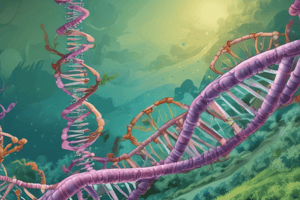Podcast
Questions and Answers
What is the primary purpose of genetic engineering?
What is the primary purpose of genetic engineering?
- To introduce new traits or characteristics into an organism (correct)
- To understand the function of genes
- To analyze the genetic makeup of an organism
- To study the structure of DNA
Which technique is used to amplify specific DNA sequences?
Which technique is used to amplify specific DNA sequences?
- Gene Cloning
- Gene Therapy
- Polymerase Chain Reaction (PCR) (correct)
- Recombinant DNA Technology
What is the result of gene cloning?
What is the result of gene cloning?
- A modified gene
- A deleted gene
- Multiple copies of a gene (correct)
- A single copy of a gene
What is the purpose of restriction enzymes in recombinant DNA technology?
What is the purpose of restriction enzymes in recombinant DNA technology?
Which application of genetic engineering involves the production of therapeutic proteins?
Which application of genetic engineering involves the production of therapeutic proteins?
What is the result of introducing recombinant DNA molecules into cells?
What is the result of introducing recombinant DNA molecules into cells?
Which of the following is an example of a gene therapy application?
Which of the following is an example of a gene therapy application?
What is the purpose of ligases in recombinant DNA technology?
What is the purpose of ligases in recombinant DNA technology?
Which technique involves inserting a gene into a plasmid or vector?
Which technique involves inserting a gene into a plasmid or vector?
What is the benefit of developing pest-resistant crops through genetic engineering?
What is the benefit of developing pest-resistant crops through genetic engineering?
Flashcards are hidden until you start studying
Study Notes
What is Genetic Engineering?
Genetic engineering is the process of altering the DNA of an organism to introduce new traits or characteristics. This is done by manipulating genes, which are the basic units of heredity.
Key Techniques
1. Recombinant DNA Technology
- Involves combining DNA from different sources into a single molecule
- Uses restriction enzymes to cut DNA, and ligases to join DNA fragments
- Creates recombinant DNA molecules that can be introduced into cells
2. Polymerase Chain Reaction (PCR)
- Amplifies specific DNA sequences
- Uses primers to target specific DNA regions, and an enzyme to replicate DNA
3. Gene Cloning
- Creates multiple copies of a gene
- Involves inserting a gene into a plasmid or vector, and introducing it into a host cell
Applications
1. Medicine
- Production of insulin, growth hormone, and other therapeutic proteins
- Gene therapy for genetic disorders
2. Agriculture
- Development of pest-resistant and drought-tolerant crops
- Increased crop yields and nutritional value
3. Biotechnology
- Production of biofuels, bioproducts, and bioremediation agents
- Development of biosensors and diagnostic tools
Ethical Concerns
- Unintended consequences of genetic modifications
- Potential for genetic discrimination
- Patenting and ownership of genetically modified organisms
Safety Considerations
- Containment of genetically modified organisms to prevent environmental release
- Risk of horizontal gene transfer
- Potential for allergic reactions or toxicity
Regulation
- National and international regulations governing genetic engineering
- Guidelines for responsible conduct of genetic engineering research
- Public engagement and participation in decision-making processes
Studying That Suits You
Use AI to generate personalized quizzes and flashcards to suit your learning preferences.




